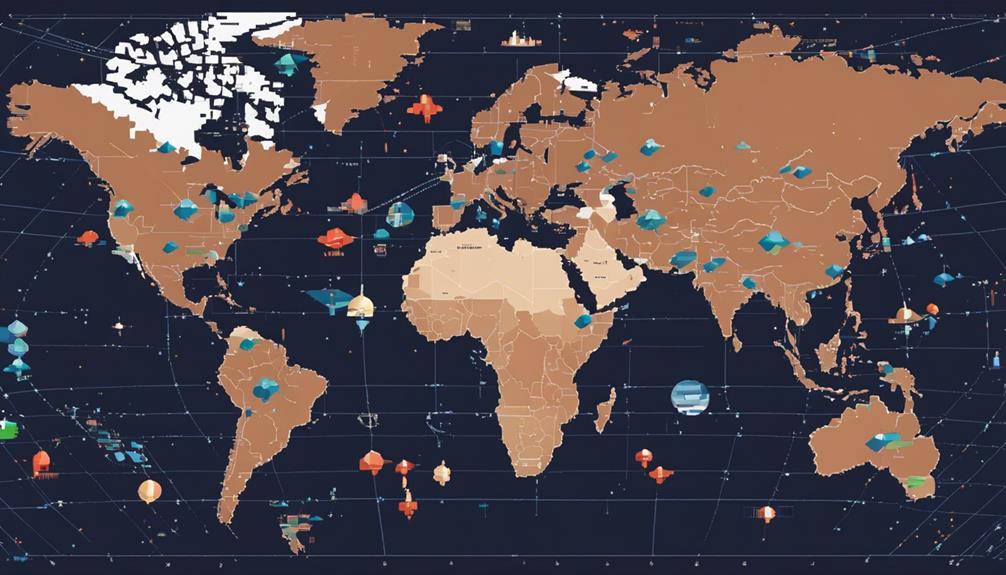In the rapidly evolving landscape of satellite broadband services, the emergence of OneWeb as a formidable competitor to Starlink has sparked considerable interest and debate among industry experts. With both companies striving to revolutionize global connectivity through innovative satellite technology, the distinct approaches taken by OneWeb and Starlink in terms of target markets, technological advancements, and strategic positioning have set the stage for a captivating competition in the realm of satellite internet services. The implications of this rivalry extend beyond mere commercial interests, raising pertinent questions about the future trajectory of satellite-based communication networks and the broader impact on digital connectivity worldwide.
Key Takeaways
- OneWeb aims for global coverage, challenging Starlink's presence in over 30 countries.
- OneWeb focuses on commercial and IoT sectors with high-speed, low-latency connectivity.
- OneWeb's strategic expansion plans target underserved areas and 35 more African countries.
- OneWeb's competitive edge in reshaping connectivity signifies a strong rivalry with Starlink.
OneWeb Satellite Internet Overview

OneWeb, a prominent player in the satellite internet industry, is set to revolutionize connectivity through its deployment of 648 low Earth orbit satellites, orbiting at approximately 750 miles above the Earth's surface, with a particular focus on expanding broadband services in South Africa. This strategic move marks a significant step in OneWeb's mission to provide high-speed internet access to various sectors in South Africa, including underserved areas. OneWeb, owned by Eutelsat, is introducing low Earth orbit (LEO) broadband service in South Africa as part of its global initiative.
The deployment of 648 satellites globally by OneWeb is aimed at ensuring comprehensive coverage for its satellite internet services. By strategically positioning these satellites in low Earth orbit, OneWeb can offer reliable and high-speed internet connectivity to users in South Africa and beyond. Furthermore, OneWeb's plans to expand its services to 35 more African countries in the long term demonstrate the company's commitment to bridging the digital divide in the region.
In targeting sectors like retail, healthcare, and agriculture, OneWeb aims to leverage its satellite internet services to drive innovation and growth across various industries. By providing access to high-speed internet in areas where traditional connectivity infrastructure is lacking, OneWeb is poised to transform the digital landscape in South Africa and beyond.
OneWeb's Technological Advancements
Incorporating cutting-edge technology, OneWeb's recent advancements in satellite internet infrastructure have significantly enhanced global connectivity capabilities. OneWeb's satellites operate in low Earth orbit (LEO) at a distance of 1,200 km from the Earth's surface. This strategic positioning enables the company to offer high-speed internet services with low latency, ensuring a seamless user experience with latency below 100 milliseconds.
As of January 10, 2023, OneWeb has successfully launched 618 satellites worldwide to bolster its internet services. To expedite its network expansion and improve coverage, OneWeb leverages SpaceX rockets for satellite launches, showcasing a strategic partnership aimed at enhancing its network infrastructure efficiently.
Moreover, OneWeb's user terminals deliver impressive speeds, offering up to 195Mbps download and 32Mbps upload rates. These high-speed capabilities cater to the increasing demand for reliable internet connectivity, empowering users with efficient data transfer rates for various online activities.
OneWeb's technological advancements align with its vision to broaden global connectivity by targeting commercial audiences and enhancing services for the Internet of Things (IoT) sector. By continuously innovating and expanding its network capabilities, OneWeb solidifies its position as a formidable competitor in the satellite internet industry, poised to deliver cutting-edge solutions for enhanced connectivity on a global scale.
OneWeb's Constellation Strategy

With a strategic focus on global coverage and operational efficiency, OneWeb is strategically planning to deploy a constellation of 648 satellites orbiting at an altitude of approximately 750 miles above Earth. This satellite constellation strategy is designed to provide widespread coverage while maintaining an optimal number of satellites in orbit. Key aspects of OneWeb's constellation strategy include:
- Efficient Global Coverage: OneWeb's approach emphasizes the importance of offering seamless connectivity worldwide through its satellite constellation. By strategically distributing 648 satellites around the globe, the company aims to ensure that even remote regions can access high-speed internet services.
- Optimized Operational Efficiency: By deploying a specific number of satellites, OneWeb can achieve operational efficiency in managing and maintaining its constellation. This targeted approach allows for effective resource utilization and streamlined operations, contributing to the overall reliability of the network.
- Scalability and Future Expansion: OneWeb's constellation strategy not only focuses on current coverage needs but also considers future expansion plans. With intentions to extend services to additional African countries and target specific sectors like retail, healthcare, and agriculture, the constellation's design allows for scalability and adaptability to meet evolving demands.
Through its satellite constellation strategy, OneWeb aims to establish a robust global presence and provide reliable internet services to various sectors across regions like South Africa, demonstrating its commitment to connectivity and innovation.
Starlink Vs. Oneweb: a Comparison
When comparing Starlink and OneWeb, key points to consider include speed and latency, coverage and availability, as well as pricing and plans. Starlink boasts low latency and high-speed data without data caps, catering to users who require consistent performance. On the other hand, OneWeb's focus on serving businesses and its offering of limited home internet in specific regions may appeal to different consumer segments.
Speed and Latency
Comparing the latency and speed performance between Starlink and OneWeb satellite systems reveals significant differences in their orbital positioning and corresponding latency metrics. Starlink's satellites, operating at 550 km from Earth, offer a low latency of around 40-50 milliseconds, appealing to users requiring swift data transmission. On the other hand, OneWeb's satellites, positioned at 1,200 km from Earth, provide latency below 100 milliseconds, suitable for tasks tolerating slightly higher delays. This distinction in latency performance is crucial for applications where real-time data is paramount, influencing the choice between these satellite internet providers. The speed and latency metrics play a vital role in determining the overall user experience and the suitability of each service for specific user needs.
Coverage and Availability
In assessing the coverage and availability of satellite internet services, a notable comparison between Starlink and OneWeb emerges, highlighting their distinct approaches to global connectivity. Starlink currently offers internet access in over 30 countries, while OneWeb aims to achieve global coverage through its constellation of 648 satellites. OneWeb's satellites orbit at a higher altitude of 1,200 km, ensuring latency below 100 milliseconds, in contrast to Starlink's lower orbit of 550 km resulting in latency around 40-50 milliseconds. Recently, OneWeb launched 36 satellites in collaboration with NewSpace India Limited, focusing on delivering global internet services to government and enterprise clients. OneWeb plans to deliver speeds of up to 195Mbps down and 32Mbps up, catering to businesses and providing mobile backhaul services for remote regions.
Pricing and Plans
The competitive landscape in satellite broadband services is shaped significantly by the pricing and plans offered by Starlink and OneWeb, emphasizing distinct strategies tailored for different market segments.
Key Points:
- Starlink offers internet plans starting at $99 per month, targeting residential customers.
- OneWeb's pricing is expected to be competitive in the market, focusing on commercial sectors like retail, healthcare, and agriculture.
- Both companies aim to provide high-speed internet services, with speeds up to 200Mbps, to bridge the digital divide through their satellite internet offerings. OneWeb's competitive pricing and target audience diversification position it as a strong competitor to Starlink in the satellite broadband market.
Target Markets and Objectives
OneWeb strategically targets commercial audiences, such as government customers and enterprise clients, in its mission to revolutionize global connectivity and enhance the Internet of Things through its advanced satellite internet services. Unlike Starlink, which primarily focuses on residential users, OneWeb aims to cater to the specific needs of organizations and governments worldwide.
With its satellite network, OneWeb is committed to expanding connectivity to even the most remote areas, providing services that can benefit regions lacking traditional internet infrastructure. By aiming to provide mobile backhaul services to underserved areas, OneWeb shows a dedication to bridging the digital divide and enabling access to reliable internet connections where terrestrial networks may not reach.
The utilization of SpaceX rockets for satellite launches ensures a reliable and efficient deployment of OneWeb's satellite constellation. With satellites orbiting at 1,200 km from Earth, OneWeb can offer low latency below 100 milliseconds, enhancing the performance of its services for government customers and enterprises relying on real-time data transmission and communications.
Satellite Network Scale Comparison

One crucial aspect in comparing satellite network scales between OneWeb and Starlink lies in the analysis of network coverage and evaluation of bandwidth speeds. Understanding the extent of coverage each network offers and the speed at which data can be transmitted are fundamental metrics for assessing their capabilities. These points will shed light on how each company's satellite constellation is positioned to meet the demands of users worldwide.
Network Coverage Analysis
In evaluating the satellite network scale comparison between OneWeb and Starlink, a comprehensive analysis of their network coverage is essential.
Network Coverage Analysis:
- OneWeb has launched 618 satellites globally, indicating a significant investment in expanding its network coverage.
- The recent collaboration with NewSpace India Limited to launch 36 additional satellites demonstrates a strategic move towards enhancing global coverage.
- OneWeb's goal of achieving global coverage by the end of the year positions it as a strong competitor in providing network services to remote and underserved regions.
These developments highlight OneWeb's commitment to expanding its network coverage on a global scale, catering to the connectivity needs of government, enterprise customers, and regions lacking adequate infrastructure.
Bandwidth Speed Evaluation
Analyzing the bandwidth speed capabilities of satellite networks such as OneWeb and Starlink provides valuable insights into their performance metrics and market positioning within the satellite internet industry. OneWeb aims to offer bandwidth speeds of up to 200 Mbps, catering to the increasing demand for high-speed internet access. In contrast, Starlink currently provides home internet services with speeds ranging from 20-100 Mbps in the U.S., showcasing differing performance levels between the two providers. OneWeb's emphasis on fast internet for businesses and underserved areas aligns with its goal of reducing the digital divide through improved connectivity. Meanwhile, Starlink excels in low latency and offers unlimited high-speed data services, appealing predominantly to residential consumers across various continents. These distinct speed offerings highlight the diverse target markets and capabilities of OneWeb and Starlink within the satellite internet landscape.
OneWeb's Service Availability
Deploying its LEO broadband service in South Africa, OneWeb enters into a strategic partnership with Airtel Africa to conduct trials and expand its coverage in the region. The collaboration aims to cover Airtel's footprint in South Africa by the end of the year. OneWeb has already set up the first African satellite network portal in Hartebeesthoek, South Africa, with plans for additional portals in Senegal, Ghana, and Mauritius. While awaiting licensing confirmation, OneWeb has been well-received in various business sectors.
Evoke Emotion Numeric List:
- Hope: Bringing satellite internet to Africa signifies a leap towards bridging the digital divide.
- Excitement: The partnership between OneWeb and Airtel Africa promises enhanced connectivity in underserved regions.
- Opportunity: OneWeb's focus on sectors like healthcare, mining, and tourism in Africa opens doors for growth and innovation.
The service availability of OneWeb in Africa not only holds promise for improved internet access but also underlines the potential for transformative impact in various industries. By strategically establishing partnerships and infrastructure across the continent, OneWeb is gearing up to play a significant role in enhancing connectivity and driving development in Africa through its satellite internet services.
Speed and Performance Evaluation

With a focus on high-speed connectivity and low latency, OneWeb's performance in the satellite internet market stands out, particularly in comparison to traditional providers. OneWeb is expected to offer speeds up to 200 Mbps, surpassing the speeds provided by most traditional satellite internet companies. In contrast, Starlink offers speeds ranging from 20-100 Mbps for home internet in the U.S., making OneWeb a strong contender in the high-speed connectivity segment.
To provide a clearer comparison between OneWeb and Starlink in terms of speed and performance, the table below outlines key aspects of both services:
| Aspect | OneWeb | Starlink |
|---|---|---|
| Maximum Speed | Up to 200 Mbps | 20-100 Mbps |
| Latency | Low latency | Low latency |
| Data Availability | Limited high-speed data | Unlimited high-speed data |
| Target Market | Businesses | Residential consumers |
OneWeb's emphasis on high-speed connectivity and low latency caters well to businesses requiring reliable and fast internet services. On the other hand, Starlink's provision of unlimited high-speed data makes it an attractive option for residential consumers. Despite the different target markets, both companies excel in their own right in the satellite internet domain.
User Experience: Oneweb Vs. Starlink
The comparison between OneWeb and Starlink in terms of user experience hinges on the speed variance and coverage area distinctions. OneWeb's focus on high speeds up to 200Mbps for sectors like retail and agriculture contrasts with Starlink's residential user-oriented speeds of 20-100Mbps. Additionally, the satellite network designs, with OneWeb orbiting at 750 miles above Earth and Starlink's larger constellation, contribute to the varying user experiences between the two services.
Speed Comparison Analysis
How do the speeds of OneWeb and Starlink satellite internet services compare in terms of user experience? When evaluating the speed performance of these two satellite internet providers, it is crucial to consider the following factors:
- OneWeb: Offers speeds up to 200Mbps, providing competitive internet speeds for users.
- Starlink: Provides speeds ranging from 20-100Mbps for home internet in the U.S., with a focus on low latency and unlimited high-speed data, enhancing the user experience.
- Overall Comparison: While OneWeb offers higher speeds, Starlink's emphasis on low latency and unlimited data contributes to a robust user experience, particularly for those seeking consistent connectivity.
Coverage Area Differences
In terms of coverage area differences between OneWeb and Starlink satellite internet services, the global reach and satellite network positioning distinguish the two providers significantly. OneWeb boasts a satellite capacity of 648 orbiting satellites globally at around 750 miles above Earth, targeting sectors like retail, healthcare, and agriculture. On the other hand, Starlink's LEO satellites offer coverage across multiple continents, focusing on providing high-speed internet access to residential users. Below is a comparison table highlighting the key differences in coverage area between OneWeb and Starlink:
| Aspect | OneWeb | Starlink |
|---|---|---|
| Satellite Capacity | 648 satellites globally | Multiple continents coverage with LEO satellites |
| Connectivity Target | Sectors like retail, healthcare, agriculture | Home consumers |
This data showcases the distinctive approaches each provider takes in offering connectivity solutions to their target markets.
OneWeb's Pricing Structure

OneWeb's approach to pricing its satellite internet services is currently undisclosed, with a focus on competitiveness and cost-effectiveness. As OneWeb gears up to launch its satellite internet services, the pricing strategy it adopts will play a crucial role in attracting customers and establishing itself as a strong competitor in the market. Here are some key points to consider regarding OneWeb's pricing structure:
- Competitiveness: OneWeb's pricing is anticipated to be designed to compete with existing providers in the satellite internet industry. By offering competitive pricing plans, OneWeb aims to position itself as a viable alternative for individuals and businesses seeking reliable internet connectivity in remote or underserved areas.
- Cost-Effectiveness: OneWeb is likely to prioritize cost-effectiveness in its pricing strategy to appeal to a broad customer base. By providing affordable options without compromising on quality, OneWeb seeks to make satellite internet services accessible to a wide range of consumers, including those in rural locations where traditional broadband options may be limited.
- Value Proposition: The pricing approach of OneWeb is expected to revolve around providing value for different market segments. By considering factors such as speed, data limits, and specific customer needs, OneWeb aims to offer tailored packages that deliver a compelling value proposition to users across various demographics and usage patterns.
Future Prospects: OneWeb's Competitive Edge
Amidst its strategic expansion plans across multiple sectors in South Africa, OneWeb positions its infrastructure and services to compete effectively with industry giant Starlink, shaping the landscape of internet connectivity in the region. OneWeb's ambitious goal to expand to 35 more African countries in the long term underscores its commitment to delivering high-speed internet services to sectors like retail, healthcare, and agriculture in South Africa. By targeting these key industries, OneWeb aims to respond to the increasing demand for next-generation internet solutions.
The presence of OneWeb in South Africa is anticipated to fuel competition in the satellite broadband market significantly. As the demand for high-speed internet services continues to surge, OneWeb's infrastructure and services are well-positioned to rival Starlink's impact in the region. OneWeb's focus on providing high-speed, low-latency internet in underserved areas aligns perfectly with the growing need for advanced connectivity solutions in South Africa. This strategic positioning not only enhances competition in the market but also sets the stage for a transformation in internet connectivity standards, benefiting consumers and industries alike. In conclusion, OneWeb's competitive edge in the satellite broadband sector is poised to reshape the future of internet connectivity in South Africa.
Regulatory Challenges and Compliance

With Icasa's declaration of Starlink's operations as illegal in South Africa, the regulatory landscape poses significant challenges for satellite broadband providers looking to comply with licensing conditions. This development has highlighted the complexities that companies offering internet services face when entering new markets. The regulatory hurdles can impact the rollout of services and the ability to meet the growing demand for high-speed internet access, especially in regions like South Africa where the need is on the rise.
Challenges Faced by Companies Operating in the Internet Services Sector:
- Legal Compliance Struggles: Meeting the diverse regulatory requirements across different countries can be a daunting task for companies like OneWeb and Starlink, impacting their expansion plans and market penetration.
- Navigating Government Policies: Adhering to government policies while ensuring efficient service delivery poses a challenge, as changes in regulations can have profound implications on operations.
- Competing in a Dynamic Market: The rapidly evolving landscape of internet services demands constant adaptation to regulatory changes, technological advancements, and market competition to stay relevant and sustainable.
In the face of these challenges, satellite broadband providers need to establish robust compliance mechanisms to navigate the regulatory environment successfully and deliver uninterrupted services to their customers.
The Verdict: OneWeb or Starlink?
In evaluating the performance and offerings of satellite broadband providers, a comparison between OneWeb and Starlink reveals distinct focuses and strengths in serving different consumer segments. OneWeb, with robust backing from the UK government, targets businesses primarily, while Starlink concentrates on residential consumers. OneWeb currently offers limited home internet services in the UK, whereas Starlink boasts coverage across multiple continents, catering to a broader audience.
Regarding connectivity speeds, OneWeb is projected to provide speeds of up to 200 Mbps, positioning itself as a high-speed option for users. Conversely, Starlink offers speeds ranging from 20-100 Mbps in the U.S., tailoring its services for a slightly different market segment. Starlink excels in offering low latency and unlimited high-speed data for home internet users, enhancing its appeal to residential customers seeking reliable and fast internet connections.
Looking ahead, OneWeb has ambitious plans with its global satellite constellation launch scheduled for March 2023, aiming to achieve global internet service coverage by the year's end. On the other hand, Starlink's established network and infrastructure provide a competitive edge in the current market landscape. Ultimately, the choice between OneWeb and Starlink depends on the specific needs and preferences of the consumer, with each provider offering distinct advantages in the realm of satellite broadband services.
Frequently Asked Questions
Does Oneweb Compete With Starlink?
Yes, OneWeb competes with Starlink in the satellite internet market. OneWeb's advantages lie in its focus on delivering high-speed internet solutions to businesses and its lower latency due to satellites orbiting at 1,200 km from Earth. In terms of future plans, OneWeb aims to expand its satellite network to enhance global connectivity. By leveraging SpaceX rockets for launches, OneWeb showcases its technological prowess in the industry, positioning itself as a formidable competitor to Starlink.
Who Can Compete With Starlink?
In the realm of satellite internet advancements, identifying competitors capable of challenging Starlink, despite SpaceX's dominance, is a complex task. Several factors, including technological innovation, regulatory hurdles, and market penetration, play pivotal roles in SpaceX's challenges. Potential contenders must demonstrate the ability to offer comparable or superior services in terms of speed, coverage, and reliability to effectively compete in the satellite broadband market.
Who Is China's Starlink Competitor?
China's satellite competitor in the space race is the Hongyun Project, developed by China Aerospace Science and Industry Corp. This initiative aims to rival Starlink by deploying a constellation of LEO satellites to provide global internet coverage. With plans to launch 156 satellites by 2022 and expand to over 800 by 2025, the project leverages advanced technology to offer high-speed internet, IoT connectivity, and satellite-based services, catering to rural areas and international markets.
What Is Comparable to Starlink Internet?
When discussing technology comparable to Starlink's satellite internet service, OneWeb's satellite internet technology stands out. OneWeb's advanced satellite internet infrastructure offers high-speed connectivity, rivaling Starlink's capabilities. With a focus on providing reliable and fast internet access via satellite technology, OneWeb's offerings align with the demands for efficient satellite internet services. The technological prowess of OneWeb's satellite internet solutions positions it as a key player in the satellite internet market.
